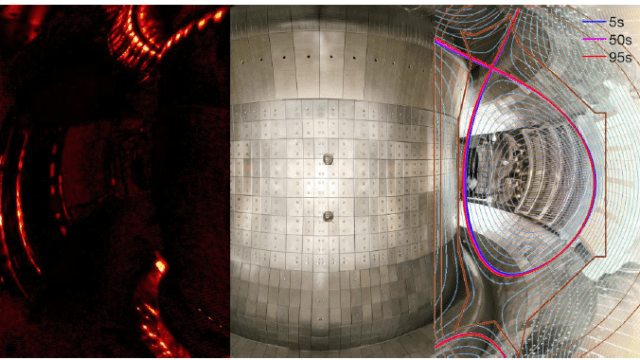This Is How We Will Discover The Most Distant Galaxy Ever
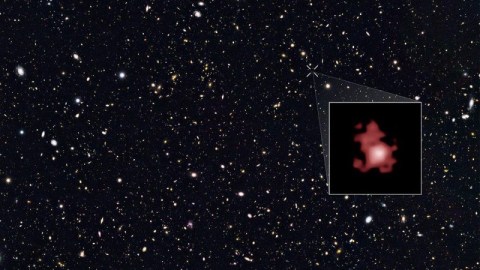
Hubble holds the record, finding a galaxy when the Universe was just 3% it’s age. In just a few years, James Webb will shatter it.
One of the great scientific lessons from the 20th century is that no matter where you go in the Universe, there’s no escape from the glittering galaxies that populate the entirety of space. In all directions, at all distances, if you look deeply enough, your telescope’s eyes will reveal a spectacular collection of light coming from billions upon billions of light years away. Over the 13.8 billion years have passed since the Big Bang occurred, and for all of that time, the Universe has been expanding while gravitation has been attracting every quantum of mass to every other one. By the present day, the visible part of our Universe contains 2 trillion galaxies.
A key challenge for modern astronomers is to find the most distant one possible. The current record-holder is spectacular, but it’s also bound to fall in the near future. Here’s the science of how.
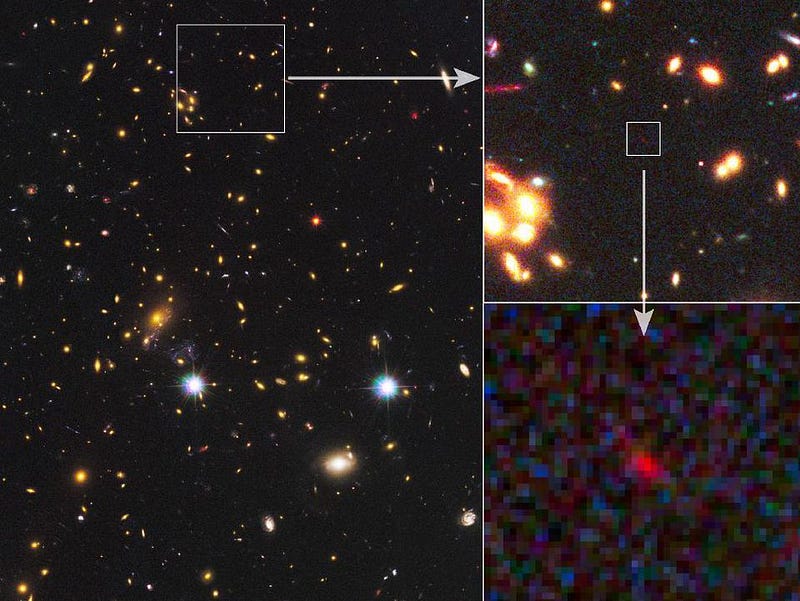
The first step to finding the most distant galaxy you can is simply to look at a seemingly-empty region of space as deeply as possible. That means gathering the greatest amount of light you can at the highest-resolution possible, enabling you to determine the structure of what you’re attempting to view.
Our cosmic record-holders have, for a generation now, come from using observatories like the Hubble Space Telescope to hone in on a particular, small region of the sky for hours, days, or even weeks at a time. If you observe an object for twice as long, you can collect twice as much light, enabling you to detect a galaxy that’s only half as bright. By imaging the same region of sky for a total 23 days, Hubble’s XDF (eXtreme Deep Field) reigns supreme as our deepest image of a portion of the distant Universe.
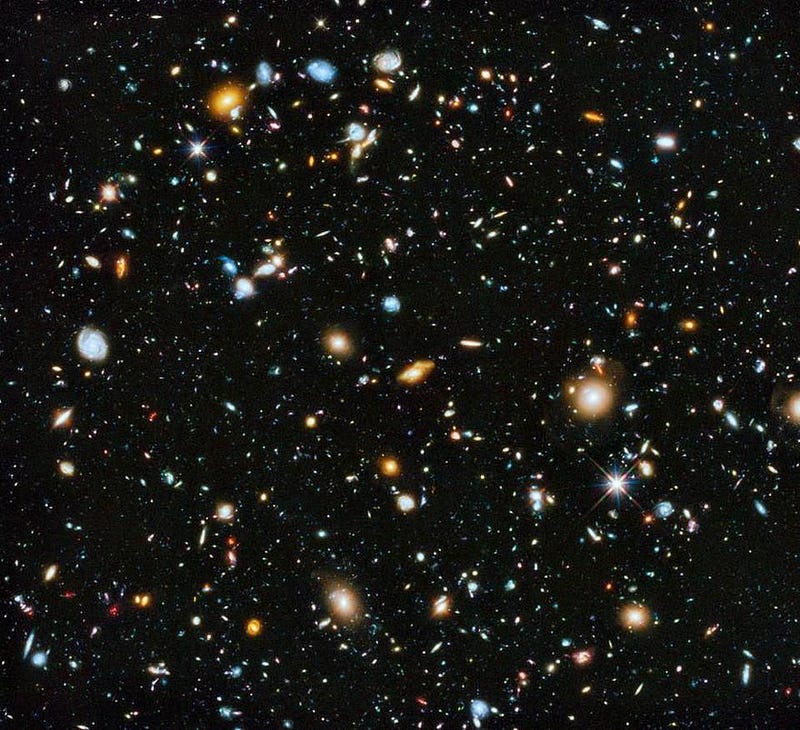
But this is not where we’ve found the most distant galaxy of all, despite putting all this time and energy into viewing this tiny region of space. Sure, we’ve observed a whopping 5,500 galaxies in a minuscule area that represents just 1/32,000,000th of the entire sky, including numerous galaxies that are tens of billions of light years away.
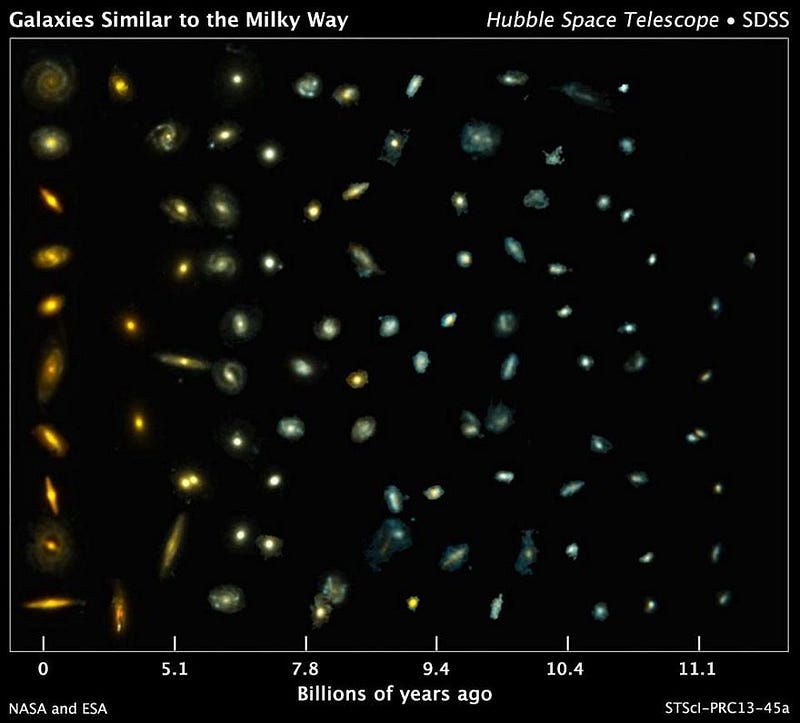
Through observations like this one, we’ve been able to determine some spectacular facts that confirm our picture of the Universe. In particular, we’ve learned that:
- distant galaxies are smaller and less massive than modern ones, indicating that they merge and grow over time,
- they’re bluer in color and are intrinsically more luminous, indicating that they formed new stars more frequently at early times,
- and there are fewer ellipticals and more spirals and irregulars in the distant Universe, teaching us that today’s galaxies are quite evolved.
We’ve also learned, in addition, that most of the galaxies we expect to be there have not yet been seen by our current observatories, as they are too faint and distant for the current generation of telescopes to reveal.
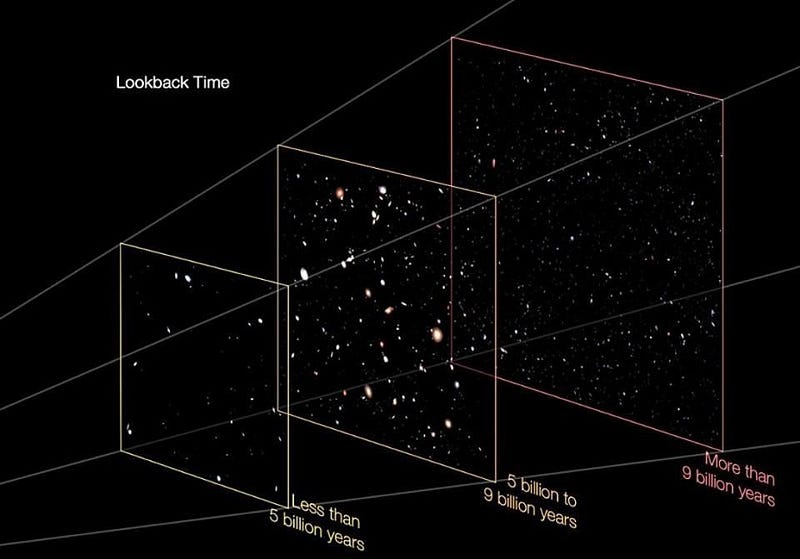
You might also have caught a troubling fact: that the Universe is just 13.8 billion years old, but that the most distant galaxies are tens of billions of light-years away. That was no typo; this is due to the fact that the Universe is expanding. When a distant galaxy emitted light in the past, it was located a specific distance from us at that moment of emission. But as the light travels towards us, time passes and the fabric of space stretches and expands. The distant galaxy, even after the light left it, continues to recede from us. The light itself still travels at the speed of light, but has more space to pass through and gets stretched, itself, by the expansion of the Universe. By time it arrives, it’s traveled for over 13 billion years, but the object that emitted it is now some ~30 billion light years away, and the light is redder and longer-wavelength than when it was first emitted.
Finally, the Universe itself has evolved over time. In the earliest stages of the hot Big Bang, there were only free particles, as everything was too energetic to form a stable, bound structure of any type. As it expanded and cooled, we formed protons, atomic nuclei, and neutral atoms. Eventually those neutral atoms came together under the force of gravity to clump and cluster together, leading to the formation of the first starsand, later, the first galaxies.
There’s another problem that arises, though, with viewing the first galaxies: they’re still embedded in a sea of neutral atoms. And just like we see in our own galaxy today, neutral atoms block the visible light emitted from stars. It’s the hot, ionizing, ultraviolet radiation that the newly-formed stars emit that will kick the electrons off of those atoms and eventually re-ionize the Universe, but that doesn’t happen until the Universe is over half-a-billion years old.
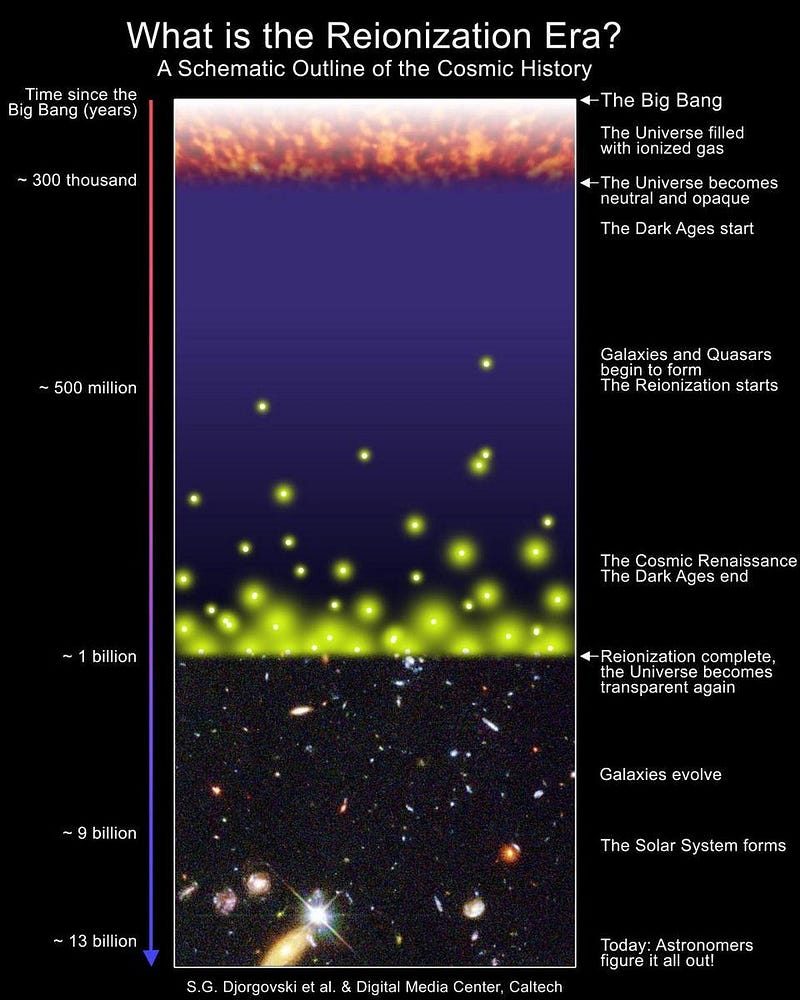
All told, there are three great obstacles to overcome in trying to find the most distant galaxy possible:
- overcoming the difficulty in seeing ultra-faint, ultra-distant objects,
- compensating for the expansion of the Universe and its effect on starlight, and
- finding a way to see through the neutral atoms that would block the starlight shortly after it’s emitted.
We’ve gotten very, very lucky in finding the current record-holder: galaxy GN-z11.
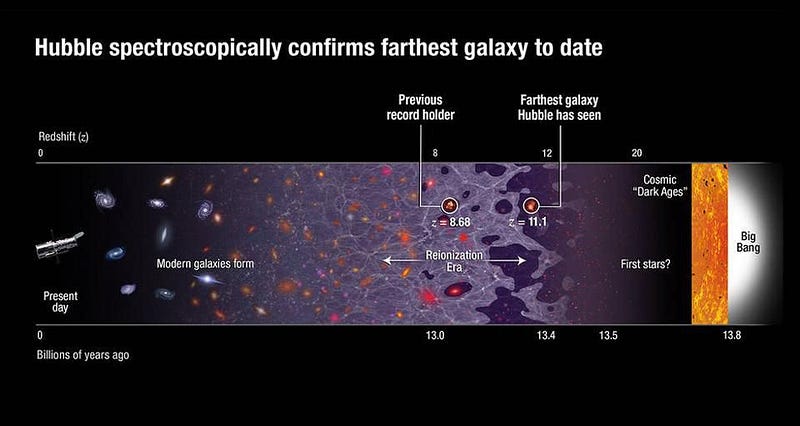
It was magnified by a chance alignment with a foreground galaxy cluster, which gravitationally lensed it. It happened to be located along a line-of-sight that was mostly, serendipitously already reionized. And, perchance, it was located in a region of sky that the Hubble Space Telescope happened to view with its upgraded, infrared-seeing camera.
But to go deeper, we won’t be able to rely on this kind of luck repeating or even extending itself. Instead, we’ll use a series of three techniques, combined, to increase our odds of going deeper than ever before. Here’s what they are.
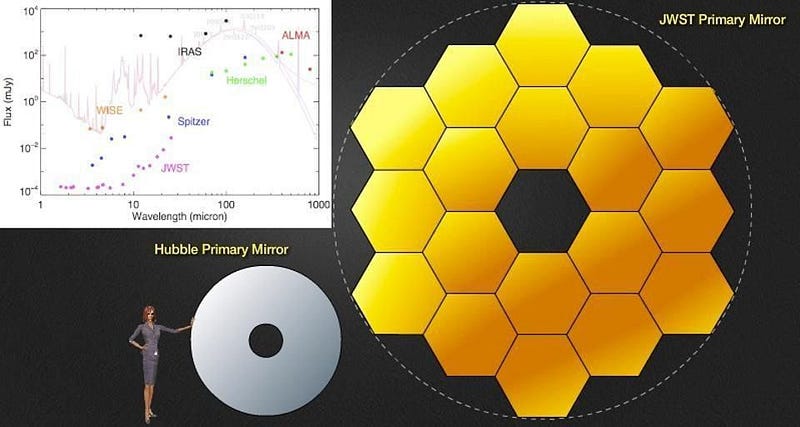
1.) Develop larger, longer-wavelength observatories to view the distant Universe. Build a bigger telescope seems like the most obvious thing to do, and it will certainly help. From space, going from Hubble (2.4m diameter) to James Webb (6.5m diameter) means a more-than-sevenfold increase in light-gathering power. From the ground, going from Keck (11m) to the Giant Magellan Telescope (25m) or the E-ELT (39m) is a similar increase. By viewing the same region of sky for a day instead of a week, we can collect the same amount of light at even greater resolution.
But by viewing in the infrared, we can get that deeply-redshifted light that Hubble is no longer sensitive to. In the case of James Webb in particular, we can go to such long (mid-IR) wavelengths that much of the redshifted starlight we see will pass right through the intervening, light-blocking neutral atoms. It’s the easiest way to win.
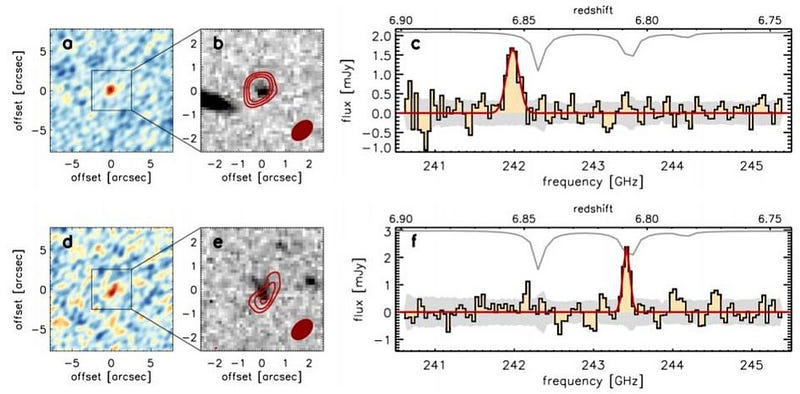
2.) Don’t just look for red light; use spectroscopy to determine the distance automatically. When all we do is look for faint objects with severely-redshifted light, we run the risk of fooling ourselves. Many of the ultra-distant candidate galaxies we’ve found have turned out to be impostors: moderately redshifted galaxies that are intrinsically redder than we expected.
The only way we can confirm a distance for these objects is by breaking up their light into different wavelengths, and finding the key features that indicate atomic absorption or emission. Thankfully, this is one of the things James Webb and the next-generation ground-based telescopes are designed to do. In the case of James Webb, the Canadian Space Agency’s Near-InfraRed Imager and Slitless Spectrograph (NIRISS) will perform wide-field spectroscopy, aperture-masking interferometry, and broad-band imaging across its entire field-of-view, which should reveal the earliest stars and galaxies.
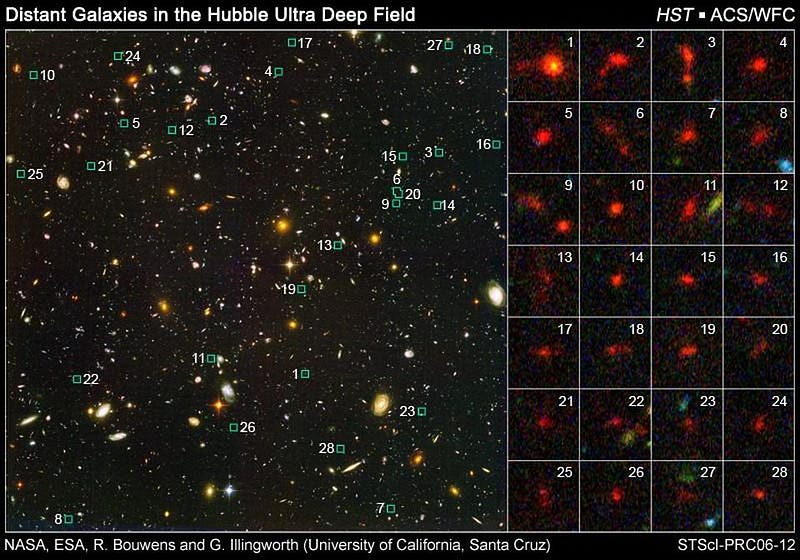
3.) Location, location, location. Don’t just use a better telescope with better resolution, better light-gathering power, superior wavelength coverage and better instrumentation to maximize the information we can extract from every photon. In addition, use the natural magnifiers the Universe provides us with: the gravitational lenses provided by massive galaxies, quasars, and galaxy clusters.
Every mass in the Universe bends the fabric of space, and this provides regions surrounding these giant masses where background objects will be lensed, stretched, and magnified. In many cases, objects that would otherwise be invisible can have their brightnesses enhanced by more than a factor of 10. Many surveys have mapped out the gravitational fields around a large number of massive galaxy clusters; looking here will be the starting point for going farther than ever before.
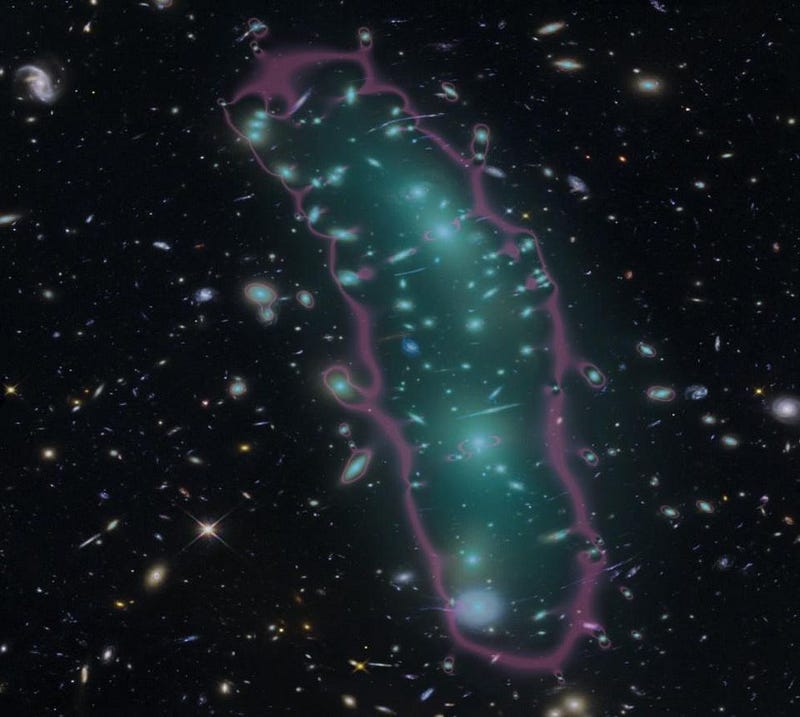
Sometime in the distant past, likely when the Universe was less than 2% its current age, the very first galaxy of all formed when massive star clusters merged together, resulting in an unprecedented burst of star formation. The high-energy light from these stars struggles to escape, but the longer-wavelength light can penetrate farther through neutral atoms. The expansion of the Universe redshifts all the light, stretching it far beyond anything Hubble could potentially observe, but next-generation infrared telescopes should be able to catch it. And if we observe the right part of the sky, with the right instruments, for a sufficiently long time to reveal the right details about these objects, we’ll push back the cosmic frontier of the first galaxies even farther.
Somewhere, the most distant, first galaxy of all is out there, waiting to be discovered. As the 2020s approach, we can feel confident that we’ll not only shatter the current cosmic record-holder, but we know exactly how we’ll do it.
Ethan Siegel is the author of Beyond the Galaxy and Treknology. You can pre-order his third book, currently in development: the Encyclopaedia Cosmologica.





